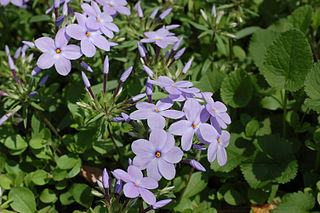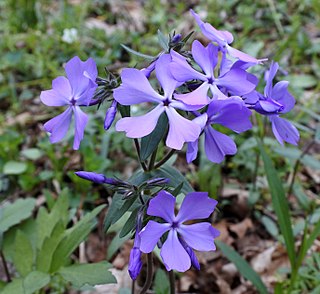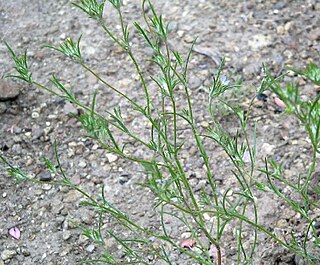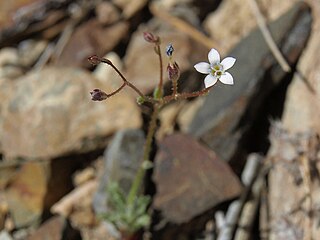
Phlox stolonifera is a species of flowering plant in the family Polemoniaceae. It is a perennial herbaceous plant that is native to the eastern United States. It occurs in woodlands and stream banks in the vicinity of the Appalachian Mountains from Pennsylvania south to northern Georgia. Naturalized populations occur as far north as Québec, Canada.

Gilia is a genus of between 25 and 50 species of flowering plants in the Polemoniaceae family and is related to phlox. These Western native plants are best sown in sunny, well-draining soil in the temperate and tropical regions of the Americas, where they occur mainly in desert or semi-desert habitats

Phlox hoodii, the spiny phlox or carpet phlox, is a species of phlox. It is a plant of western North America, where it is a common flower in sagebrush country, mostly growing in dry lithosol habitats. It is among the first plants to bloom in spring, after the snow has melted. Its distribution extends from Alaska to Arizona. There are many subspecies.

Phlox divaricata, the wild blue phlox, woodland phlox, or wild sweet william, is a species of flowering plant in the family Polemoniaceae, native to forests and fields in eastern North America.

Phlox pilosa, the downy phlox or prairie phlox, is an herbaceous plant in the family Polemoniaceae. It is native to eastern North America, where it is found in open areas such as prairies and woodlands.

Eriastrum pluriflorum is a species of flowering plant in the phlox family known by the common names Tehachapi woollystar and many-flowered eriastrum.

Gilia stellata is a species of flowering plant in the phlox family known by the common name star gilia. It is native to the southwestern United States and northern Mexico, where it is a common resident of desert washes and sandy mountain slopes.
Ipomopsis tenuituba is a species of flowering plant in the phlox family known by the common name slendertube skyrocket, or slendertube ipomopsis. It is native to much of the western United States from California to Colorado, where it is found on rocky mountain slopes. This is a perennial herb producing an erect stem with widely spaced leaves, each 3 to 6 centimeters long and with many narrow, fingerlike lobes. The inflorescences toward the top of the stem each hold three to seven flowers. The flower is very pale to medium pink, sometimes with white streaks, or solid white. It is a tube 2 to 5 centimeters long, opening into a corolla of five twisting, pointed, ribbonlike lobes. The stamens and style do not protrude far from the mouth of the flower, if at all. While it is a perennial plant, it dies after its first flowering.

Eriastrum wilcoxii is a species of flowering plant in the phlox family known by the common name Wilcox's woollystar. It is native to the western United States, where it grows in various types of desert and plateau habitat. It is an annual herb producing a thin, branching, usually woolly stem up to about 30 centimeters tall. The leaves are narrow and thready, up to 3 centimeters long, and sometimes divided into two or more lobes. The inflorescence is a woolly cluster of narrow, leaflike bracts laced with webby fibers. The small flowers have yellow throats and blue corollas with lobes up to half a centimeter long.

Gilia clokeyi is a species of flowering plant in the phlox family known by the common name Clokey's gilia. It is native to the south-western United States from California to Colorado, where it grows in desert and other habitat.

Linanthus maculatus is a species of flowering plant in the phlox family known by the common names San Bernardino Mountain gilia and Little San Bernardino Mountains gilia. It is endemic to California, where it is known only from a few locales in the Little San Bernardino Mountains and the adjacent Palm Springs area in the northern end of the Coachella Valley. The largest populations, which may contain thousands of individuals, are located within the bounds of Joshua Tree National Park. This is a very small annual herb no more than three centimeters high. It has a taproot which may exceed 6 centimeters in length to collect moisture from the dry desert sand in its native habitat. The tiny, hairy stem branches to form small matted clusters on the sand surface. The hairy leaves are just a few millimeters long and unlobed. The inflorescence is a dense cluster of flowers each only 2 to 5 millimeters wide. The flower corolla has curled-back lobes which are white, sometimes with a spot of purple or pink. The protruding stamens are yellow. The main threat to this species is development in its range, and it is also vulnerable to off-road vehicle damage in the wide open sandy flats where it grows.

Leptosiphon montanus is a species of flowering plant in the phlox family known by the common name mustang clover.

Phlox diffusa is a species of phlox known by the common name spreading phlox. It is native to western North America from British Columbia to the southwestern United States to the Dakotas, where it grows in many types of habitat, including rocky, high elevation mountain slopes. It is a very compact mat-forming perennial herb growing in cushions or patches of short, decumbent stems. The linear, lance-shaped, or needle-like leaves are no more than 1.5 centimeters long and are oppositely arranged in bundles on the short stems. The inflorescence is a solitary tubular flower around a centimeter long. It has a flat white or pale pink or blue corolla with five lobes each just under a centimeter in length.
Phlox dolichantha is a species of phlox known by the common name Big Bear Valley phlox. It is endemic to San Bernardino County, California, where it is limited to the area around Big Bear Lake in the San Bernardino Mountains. It grows in forests and the unique local pebble plain habitat. It occurs at elevations over 2000 meters. It is an erect, branching perennial herb growing up to 30 centimeters tall. The linear or narrowly lance-shaped leaves are 2 to 5 centimeters long and are oppositely arranged on the slender stems. The inflorescence is made up of one or more showy flowers at the tip of the stem. Each flower has a very slender tubular throat up to 5 centimeters long which can be white, pink, or lavender.

Phlox speciosa is a species of phlox known by the common name showy phlox. It is native to western North America from British Columbia to Arizona and New Mexico, where it occurs in sagebrush, pine woodlands, and mountain forests.
Saltugilia latimeri is an uncommon species of flowering plant in the phlox family known by the common name Latimer's woodland gilia. It is endemic to California, where it is known from several scattered occurrences in the western Mojave Desert and outlying areas to the north. It occurs in dry rocky and sandy desert canyons. It was first described as a species in 2001.

Passiflora mixta, from the family Passifloraceae is also known as curuba, curuba de indio, curuba de monte, curubita, curuba (Colombia), parcha (Venezuela), and taxo (Ecuador). Originally, it derived from the monophyletic Passiflora subgenus Tacsonia. Passiflora mixta is endemic to the Americas. A perennial vine, the Passiflora mixta is pink to orange-red in color.

Saltugilia is a genus of flowering plants in the phlox family, Polemoniaceae. They are known commonly as woodland gilias. There are four species. Two are endemic to California in the United States, and the distributions of the other two extend into Baja California in Mexico.

Aliciella latifolia, also known as broad-leaved gilia, is a foul smelling annual plant in the Phlox family (Polemoniaceae) found in deserts of the southwestern United States.

Phlox pulchra, commonly known as Wherry’s phlox or Alabama phlox, is a perennial species of flowering plant in the family Polemoniacea. It is endemic to Alabama in the United States and historic to nine counties Some occurrences are greatly diminished in size or extirpated, others have not been officially surveyed since the 1980s. Specimens have been vouchered in at least five of these counties. It was originally collected by Dr. Wherry in 1929 in Walker County and thought to be Phlox ovata. Under his cultivation, it was observed to differ as follows: sterile shoot present with partially evergreen leaves, small number of nodes on flowering shoots, large calyx and corolla. He published his findings in the journal Bartonia in 1934. The plant was collected in Walker County by Weezie Smith for Dr. Wherry prior to the publication of his book, The Genus Phlox, in 1955, which details the taxa. The showy, compact flowers bloom in May and June in a color spectrum from bright pink, delicate rose to soft peach and occasionally white. Phlox pulchra, for this reason, has horticulture appeal and is available as “Bibb Pink” and “Eco Pale Moon” cultivars.


















